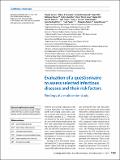| dc.contributor.author | Sievers, Claudia | en_US |
| dc.contributor.author | Akmatov, Manas K. | en_US |
| dc.contributor.author | Kreienbrock, Lothar | en_US |
| dc.contributor.author | Hille, Katja | en_US |
| dc.contributor.author | Ahrens, Wolfgang | en_US |
| dc.contributor.author | Günther, Kathrin | en_US |
| dc.contributor.author | Flesch-Janys, Dieter | en_US |
| dc.contributor.author | Obi, Nadia | en_US |
| dc.contributor.author | Michels, Karin B. | en_US |
| dc.contributor.author | Fricke, Julia | en_US |
| dc.contributor.author | Greiser, Karin H. | en_US |
| dc.contributor.author | Kaaks, Rudolf | en_US |
| dc.contributor.author | Peter, Hans-Hartmut | en_US |
| dc.contributor.author | Pessler, Frank | en_US |
| dc.contributor.author | Nieters, Alexandra | en_US |
| dc.contributor.author | Krause, Gérard | en_US |
| dc.date.accessioned | 2014-11-03T17:39:02Z | |
| dc.date.issued | 2014 | en_US |
| dc.identifier.citation | Sievers, C., M. K. Akmatov, L. Kreienbrock, K. Hille, W. Ahrens, K. Günther, D. Flesch-Janys, et al. 2014. “Evaluation of a questionnaire to assess selected infectious diseases and their risk factors: Findings of a multicenter study.” Bundesgesundheitsblatt, Gesundheitsforschung, Gesundheitsschutz 57 (11): 1283-1291. doi:10.1007/s00103-014-2052-y. http://dx.doi.org/10.1007/s00103-014-2052-y. | en |
| dc.identifier.issn | 1436-9990 | en |
| dc.identifier.uri | http://nrs.harvard.edu/urn-3:HUL.InstRepos:13347478 | |
| dc.description.abstract | Background/objectives The risk to die from an infectious disease in Germany has been continuously decreasing over the last century. Since infections are, however, not only causes of death but risk factors for diseases like cardiovascular diseases, it is essential to monitor and analyze their prevalence and frequency, especially in consideration of the increased life expectancy. To gain more knowledge about infectious diseases as risk factors and their implications on the condition and change of the immune status, the German National Cohort (GNC), a population-based prospective cohort study, will recruit 200,000 subjects between 2014 and 2017. In Pretest 1, a feasibility study for the GNC, we evaluated a self-administered and self-report questionnaire on infectious diseases and on the use of health care facilities (hereinafter called “ID Screen”) for feasibility and validity. Methods: From August–November 2011, 435 participants between the ages of 20–69 completed the ID Screen. All subjects had been recruited via a random sample from the local residents’ registration offices by 4 of the 18 participating study centers. The questionnaire encompasses 77 variables in six sections assessing items such as 12-month prevalence of infections, cumulative prevalence of infectious diseases, visit of health care facilities and vaccination. The feasibility was amongst others evaluated by assessing the completeness and comprehensiveness of the questionnaire. To assess the questionnaires ability to measure “immune status” and “susceptibility to infections”, multivariate analysis was used. Results: The overall practicability was good and most items were well understood, demonstrated by < 2/33 missing questions per questionnaire and only three variables: vaccination for influenza and pneumococci and infection with chickenpox had a frequency > 5 % of missing values. However, direct comparison of the items 12-month prevalence and lifetime prevalence of nephritis/pyelitis showed poor agreement and thereby poor understanding by 80 % of the participants, illustrating the necessity for a clear, lay person appropriate description of rare diseases to increase comprehensibility. The questionnaire will be used to support the assessment of immune dysfunction and frequency of infection. An analysis of these constructs in an exploratory factor analysis revealed limited applicability due to low interitem correlation (Cronbach’s α < 0.5). This is corroborated by the extraction of more than one factor with a Kaiser–Meyer–Olkin measure of 0.6 instead of a unidimensional latent construct for “immune status”. Conclusion: All in all, the ID Screen is a good and reliable tool to measure infectious diseases as risk factors and outcome in general, but requires a better translation of infection specific terms into lay person terms. For the assessment of the overall immune status, the tool has strong limitations. Vaccinations status should also rather be assessed based on vaccination certificates than on participants’ recall. Electronic supplementary material The online version of this article (doi: 10.1007/s00103-014-2052-y) contains supplementary material, which is available to authorized users. | en |
| dc.language.iso | en_US | en |
| dc.publisher | Springer Berlin Heidelberg | en |
| dc.relation.isversionof | doi:10.1007/s00103-014-2052-y | en |
| dc.relation.hasversion | http://www.ncbi.nlm.nih.gov/pmc/articles/PMC4210746/pdf/ | en |
| dash.license | LAA | en_US |
| dc.subject | Survey validity | en |
| dc.subject | Infections | en |
| dc.subject | Questionnaires | en |
| dc.subject | Self-report | en |
| dc.subject | German National Cohort (GNC) | en |
| dc.subject | Infektionen | en |
| dc.subject | Fragebogen zu Infektionskrankheiten | en |
| dc.subject | Selbsteinschätzung | en |
| dc.subject | Validierung | en |
| dc.subject | Nationale Kohorte (NaKo) | en |
| dc.title | Evaluation of a questionnaire to assess selected infectious diseases and their risk factors: Findings of a multicenter study | en |
| dc.type | Journal Article | en_US |
| dc.description.version | Version of Record | en |
| dc.relation.journal | Bundesgesundheitsblatt, Gesundheitsforschung, Gesundheitsschutz | en |
| dash.depositing.author | Michels, Karin B. | en_US |
| dc.date.available | 2014-11-03T17:39:02Z | |
| dc.identifier.doi | 10.1007/s00103-014-2052-y | * |
| dash.authorsordered | false | |
| dash.contributor.affiliated | Michels, Karin | |


